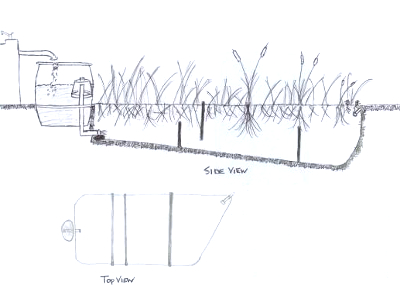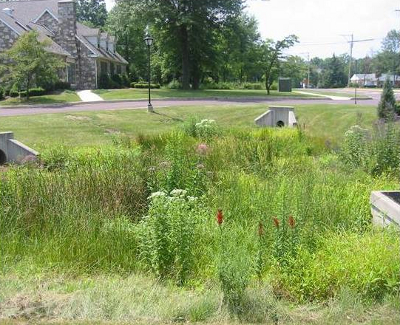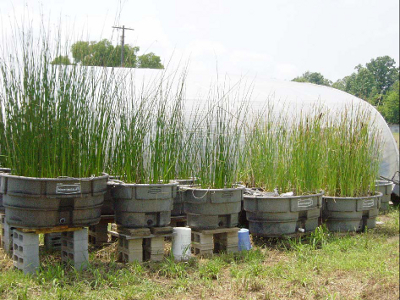
Constructed wetlands for greywater
 Although greywater will
probably continue to flow to a mulch
basin in the winter,
you risk drowning dormant trees. Instead, the system that looks
most efficient for greywater treatment during temperate winters is a
constructed wetland.
Although greywater will
probably continue to flow to a mulch
basin in the winter,
you risk drowning dormant trees. Instead, the system that looks
most efficient for greywater treatment during temperate winters is a
constructed wetland.
In general, it's much
more sanitary to filter greywater through soil than to allow the water
to pool on the surface, so most constructed wetlands for treating
greywater are more like bogs than like ponds --- in other words,
there's no standing water. Greywater enters the system through a
drain at the top, then percolates down through gravel and sand until
clean water flows out the bottom (possibly into a pond).
 In cold climates, Create
an Oasis with Greywater recommends planning about 1.5 to 3 square
feet of wetland per gallon of greywater produced each day. For
best results, the width should be about half the length, ensuring that
water has to travel a good distance before treatment is complete.
Since I estimate we use about 20 gallons of water per day at the
kitchen sink, we'd need a roughly six foot by ten foot wetland to
delete our swampy drain
out back.
In cold climates, Create
an Oasis with Greywater recommends planning about 1.5 to 3 square
feet of wetland per gallon of greywater produced each day. For
best results, the width should be about half the length, ensuring that
water has to travel a good distance before treatment is complete.
Since I estimate we use about 20 gallons of water per day at the
kitchen sink, we'd need a roughly six foot by ten foot wetland to
delete our swampy drain
out back.
Constructed wetlands get
around the issue of waterlogged soil by using aquatic plants that are
well suited to the environment. Ludwig doesn't suggest any
particular species (noting that selections are region specific), but I
suspect cattails, horsetails, sedges, water plantain, and sweet flags
would do well in our region since they live in nearby swampy
ground. Perhaps we could even cut the leaves once a year to
create mulch or deep
bedding for the chickens?
 Fixing our greywater system
isn't a top priority, but I suspect it'll make the list sometime in the
next year or two since our new porch brings traffic to an area that
used to be hidden by weeds. I'm going to hang onto Create
an Oasis with Greywater to refer back to once we hit
the planning stage for that project, and meanwhile I highly recommend
the book for anyone who wants to build a sustainable greywater
treatment system. Be sure to leave a comment if you've created a
greywater system different from the ones described in this week's
lunchtime series --- I'm always interested to see other DIY options.
Fixing our greywater system
isn't a top priority, but I suspect it'll make the list sometime in the
next year or two since our new porch brings traffic to an area that
used to be hidden by weeds. I'm going to hang onto Create
an Oasis with Greywater to refer back to once we hit
the planning stage for that project, and meanwhile I highly recommend
the book for anyone who wants to build a sustainable greywater
treatment system. Be sure to leave a comment if you've created a
greywater system different from the ones described in this week's
lunchtime series --- I'm always interested to see other DIY options.
| This post is part of our Create an Oasis with Greywater lunchtime
series.
Read all of the entries: |
Want more in-depth information? Browse through our books.
Or explore more posts by date or by subject.
About us: Anna Hess and Mark Hamilton spent over a decade living self-sufficiently in the mountains of Virginia before moving north to start over from scratch in the foothills of Ohio. They've experimented with permaculture, no-till gardening, trailersteading, home-based microbusinesses and much more, writing about their adventures in both blogs and books.
Want to be notified when new comments are posted on this page? Click on the RSS button after you add a comment to subscribe to the comment feed, or simply check the box beside "email replies to me" while writing your comment.

You don't have to go and get plants for your wetland, they will find their way there in time, hitching a ride in bird droppings, wind, or other mysterious ways. You can jump start the process by going to a local wetland and taking a shovel of soil home to yours. For my drain basin, I just put a shovel of a local swamp soil in the middle and cattails sprung out of it. I imagine that many local bacteria and fungus hitched a ride as well.
When looking at the sketch, I wonder how you are to keep the surge basin/grease trap from freezing in the winter?
Unless you bury the whole thing beneath the frost line, which sounds a bit extreme.
And 20 gallons/dag seems like a lot. My average use over a whole year is around 11 gallons/dag, and that includes showers, flushing the toilet and running the washing machine, not just the kitchen sink.
De --- I skimmed the fancier sections, so I'm afraid I can't answer that in depth. But he does go into plumbing for dual systems that can be swapped over to septic, etc. It's definitely easier to build from scratch, figuring out what system you want first, than to retrofit. (Although you may have to build the system to code, in that case, which might be a nightmare. There's a whole separate book by the same author that covers that.)
Eric --- I really liked that part of your post about (not) seeding your system, and I think I'll follow suit!
Roland --- We wouldn't be constructing one with a surge trap. I just used that sketch from the internet because I liked it otherwise and was too lazy to draw my own. Surge traps are actually a bad idea in greywater according to the author of this book because they hold water too long, which makes it go anaerobic (thus, creating bad smells).
Surge traps are actually a bad idea in greywater according to the author of this book because they hold water too long, which makes it go anaerobic (thus, creating bad smells).
The twenty gallons I estimated is mostly for dishes and washing vegetables. I was just guessing wildly, but I think our sink holds about five gallons in each basin. (Although, now that I think of it, I suspect we only fill each basin about a third of the way most of the time? Maybe my estimate is way off. )
)
According to this from UCSB, no cleaning of gravel required. Only the screens on inlet and outlet http://fiesta.bren.ucsb.edu/~chiapas2/Water%20Management_files/Greywater%20Wetlands-1.pdf